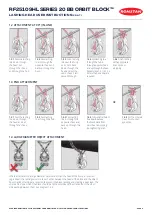
RF25109HL Series 20 BB
Orbit Block
™
Lashing Head User Instructions
Ronstan BB Orbit Blocks™ feature a unique Lashing head. Building on the latest
trends in grand prix dinghy and ocean racing, it replaces the steel head post and
shackle arrangement of traditional blocks.
IMPORTANT:
In order to meet breaking loads this block must be lashed with the
lashing, strop or link passing through the hub.
The lashing must be passed down through the head, out through the cheek, through
the hub, back in through opposite cheek and back up and out through the head.
Repeat for lines, sizes that require more than one strand to meet load rating.
The Maximum Working Load and Breaking Load of the assembly (Block + Lashing) is generally limited by the strength of
the rope and the joining method. Knots, splices, stitching, etc. will generally have a lower Breaking Load than the rope
itself. It is possible to use up to 4mm (5/32”) lashing line for lashing the RF25109 running the lashing around as a single
strand, but a neater result with more secure knotting can be achieved by using the smaller line size provided (e.g. 1.7
- 2mm) passed through multiple times. The RF25109HL Series 20 Orbit Block™ is supplied with 750mm (30”) of 2mm
(3/32”) diam. single braid Dyneema® lashing line.
For best results, the lashing must be attached to a mounting point with a smooth, well rounded profile.
Avoid attaching directly to fittings with sharp edges or rough surfaces that may damage the lashing through abrasion
or point loading. For this situation use a shackle with a smooth surface between the lashing and the fitting. Regularly
inspect the lashing for damage, if found replace immediately.
UsaGE InSTRUCTIONS
Orbit Block
™
USER INFORMATION - RF25109HL Series 20 BB Orbit Block™ Lashing Head User Instructions
Page 1.
1.0 LASHING OPTIONS
1.1 ATTACHMENT AT 0° (IN-LINE)
1.1.1
Pass the lashing
line down through
the head and out
through the cheek.
Attachment at 0°
*Must have at least 2 strands
1.1.2
Pass the lashing
line down through
the head and out
through the cheek.
Attachment at 90°
1.1.3
Pass lashing
line in through the
opposite cheek and
back up through the
head.
Line end attachment
1.1.4
Pass lashing line
around fixing point.
Repeat steps 1.1.1 to 1.1.3
if more than one strand is
required to meet desired
breaking load.
Large diameter object attachment*
1.1.5
Finish lashing
with appropriate
knot, splice or
whipping.






















